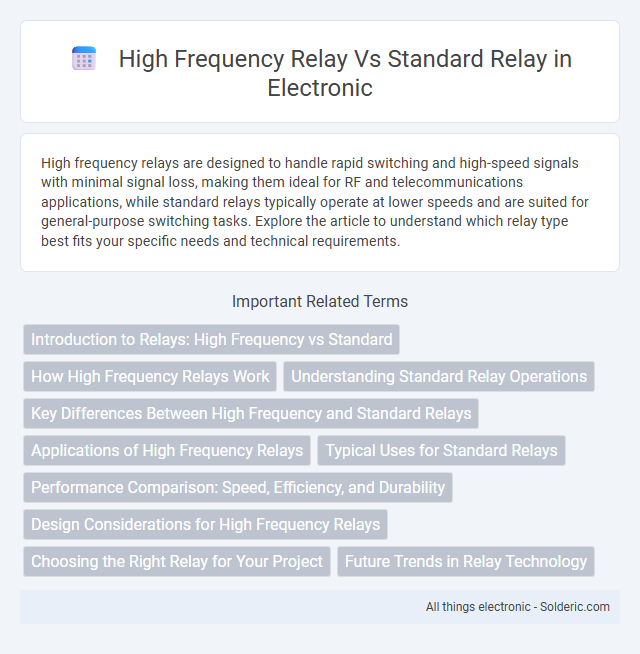High frequency relays are designed to handle rapid switching and high-speed signals with minimal signal loss, making them ideal for RF and telecommunications applications, while standard relays typically operate at lower speeds and are suited for general-purpose switching tasks. Explore the article to understand which relay type best fits your specific needs and technical requirements.
Comparison Table
| Feature | High Frequency Relay | Standard Relay |
|---|---|---|
| Operating Frequency | Up to GHz range | Up to kHz range |
| Switching Speed | Nanoseconds to microseconds | Milliseconds |
| Contact Type | Specialized low-capacitance, low-inductance contacts | Standard mechanical or solid-state contacts |
| Applications | RF circuits, signal testing, telecommunications | General control, power switching, automation |
| Power Handling | Low to moderate power, sensitive signals | Low to high power loads |
| Size | Compact design for high-frequency performance | Varies from small to large sizes |
| Cost | Higher due to specialized components | Lower cost, widely available |
Introduction to Relays: High Frequency vs Standard
High frequency relays are designed to handle fast switching and high-frequency signals, making them ideal for applications like telecommunications and RF circuits. Standard relays are typically used for general-purpose switching with lower speed and frequency tolerances, suitable for controlling power in household and industrial devices. Your choice between high frequency and standard relays depends on the specific operating frequency and switching speed requirements of your application.
How High Frequency Relays Work
High frequency relays operate using specialized contacts and construction materials designed to handle rapid switching and high-speed signal transmission with minimal signal loss or interference. These relays typically feature low contact resistance and minimal inductance, ensuring efficient operation at high signal frequencies often used in RF and telecommunications applications. In contrast to standard relays, high frequency relays maintain signal integrity through precise mechanical design and shielding to prevent electromagnetic interference.
Understanding Standard Relay Operations
Standard relay operations rely on electromagnetic coils to open or close contacts, enabling control of high-power circuits with low-power signals. These relays typically switch frequencies up to 1 kHz, making them suitable for general electrical and industrial applications. Their mechanical contacts provide reliable isolation but may experience wear and slower response times compared to solid-state or high-frequency relays.
Key Differences Between High Frequency and Standard Relays
High Frequency Relays operate efficiently at higher switching speeds and frequencies, often exceeding 10 MHz, while Standard Relays are limited to lower frequencies typically below 1 kHz. High Frequency Relays feature specialized contact materials and construction to minimize signal loss and crosstalk, ensuring superior performance in RF and microwave applications compared to Standard Relays. Your choice depends on the need for speed, signal integrity, and frequency range specific to your electronic or communication system requirements.
Applications of High Frequency Relays
High frequency relays are essential in telecommunications, radio frequency switching, and signal processing where fast and precise switching of high-frequency signals is required. Their applications include RF test equipment, microwave communications, and radar systems, offering low insertion loss and excellent isolation. These relays support rapid switching speeds and can handle signals at GHz frequencies, distinguishing them from standard relays used in power control and general-purpose switching.
Typical Uses for Standard Relays
Standard relays are commonly utilized in automotive applications, home appliances, and industrial machinery for switching moderate current loads and controlling electrical circuits. They handle tasks such as turning on lights, motors, or heating elements where frequency is relatively low and switching speed is not critical. These relays provide reliable operation in environments requiring straightforward load management and electrical isolation.
Performance Comparison: Speed, Efficiency, and Durability
High frequency relays operate at significantly faster switching speeds compared to standard relays, typically achieving response times in the microsecond range, enhancing overall system efficiency in high-speed applications. Their construction using specialized materials and contact designs improves durability by reducing wear and contact degradation under rapid cycling conditions, extending operational lifespan beyond that of standard relays. Standard relays, while generally more cost-effective and sufficient for low-frequency tasks, exhibit slower switching speeds and higher energy consumption, which can limit performance in demanding or high-frequency electrical circuits.
Design Considerations for High Frequency Relays
High frequency relays require specialized design considerations including low contact capacitance and minimal inductance to ensure signal integrity at GHz frequencies, in contrast to standard relays which prioritize mechanical durability over electrical performance. Materials such as precious metals and advanced contact coatings are used to reduce contact resistance and prevent signal degradation in high frequency applications. Your choice between high frequency and standard relays should account for the relay's switching speed, insertion loss, and impedance matching to maintain optimal performance in RF and microwave circuits.
Choosing the Right Relay for Your Project
High-frequency relays offer superior switching speeds and reduced signal distortion compared to standard relays, making them ideal for applications involving RF signals or rapid switching requirements. Standard relays provide robust performance for general-purpose use with higher current ratings and simpler control circuitry, suitable for less time-sensitive projects. Evaluating your project's signal frequency, switching speed needs, and load characteristics will help you choose the right relay to ensure optimal performance and reliability.
Future Trends in Relay Technology
High frequency relays are increasingly integrated with advanced materials like gallium nitride (GaN) to enhance switching speed and durability, surpassing the limitations of standard relays. Smart relays featuring Internet of Things (IoT) connectivity and predictive maintenance algorithms are shaping the future landscape of relay technology by enabling real-time monitoring and reducing downtime. As industries demand higher efficiency and reliability, the shift toward miniaturized, solid-state relay designs is accelerating, promoting seamless integration into compact electronic systems.
High Frequency Relay vs Standard Relay Infographic

 solderic.com
solderic.com